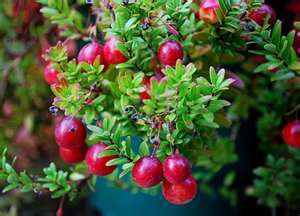Update July 10, 2017
UMass Amherst Food Scientists Find Cranberries May Aid the Gut Microbiome
Excerpt: "Many scientists are paying new attention to prebiotics, that is, molecules we eat but cannot digest, because some may promote the growth and health of beneficial microorganisms in our intestines, says nutritional microbiologist David Sela at the University of Massachusetts Amherst. In a new study, he and colleagues report the first evidence that certain beneficial gut bacteria are able to grow when fed a carbohydrate found in cranberries and further, that they exhibit a special nontypical metabolism."Well, North America just celebrated yet another one of their Thanksgiving celebrations in which one of the iconic must have food dishes served was Cranberry Sauce. Of course there are any number of favourite wintertime seasonal dishes for which the Cranberry is used. But over here in Northern Europe, it's the Lingonberry which is King or rather Queen, depending on how the word/term is used and under what *cough-cough* contextual circumstance it is being used. I'll let some of you Swedes have time to explain to all the foreigners reading here about Swedish women and Lingonberries. *smile* 😁
 |
| Lingonberry or Cowberry (Vaccinium vitis-idaea) |
http://en.wikipedia.org/wiki/Vaccinium_vitis-idaea
 |
| Credit Wiki |
 |
| image - DishMaps |
 |
| image - Lee Reich |
 |
| Credit: Privick Mill Nursery |
"According to the Wisconsin State Cranberry Growers Association, the cranberry industry provides nearly $1 billion in annual revenue for Wisconsin, which produces over half the world's supply of this tart and tiny fruit."
WISCONSIN STATE CRANBERRY GROWERS ASSOCIATION
September is harvest-time for cranberry growers, who collect the red fruit using special toothed scoops or by flooding the bogs and agitating the plants. Today’s cranberry bogs can yield as many as 15,000 pounds of fruit that can be crushed and canned or eaten fresh. Cranberries grow wild in the Northeast, and as far south as Virginia. America and Canada produce 96 percent of the world’s cranberries, using them in tarts, sauces, preserves, juices, and more.
 |
| Credit Wikitravel.org Cranberry Bog being "Wet Harvested" |
 |
| Credit Wikitravel.org Cranberry Bog being "Dry Harvested" |
 |
| Photo by Jack Greenlee |
Cranberries aren't just for holiday meals!
 |
| Image - Crystalobregon.com |
https://www.crystalobregon.com/farmers-market-friday/cranberries
READING REFERENCES:
USDA - Cranberry Fact Sheets
Cranberries, Nature’s Garnets, are Ripening Across the Country
http://www.bjorngardsvillan.se/
http://www.oceanspray.com/Products/Fresh-Fruit/Cranberries-(1).aspx
http://www.cranberries.org/
http://www.cranberryinstitute.org/
http://www.whfoods.com/genpage.php?tname=foodspice&dbid=145
http://scandinavianfood.about.com/od/scandinavianfoodglossary/g/lingonberries.htm
Oregon State Agricultural Extension: Lingonberry Production Guide for the Pacific Northwest
Washington State University: What Are Lingonberries ?
And on the lighter side of Cranberry Humor



I live in the east U.S. I made cranberry jam a few year ago, instead of cranberry sauce. It wa amazing! Slightly tart, and so good on toast.
ReplyDeleteLingonberry jam is
ReplyDeletevery tasty. I will
try making a recipe
with cranberries this
Thanksgiving holiday!
Having lived in Sweden for many years I can attest to the popularity of Lingon with almost everything. Here in the United States I make a cranberry relish with orange rind, orange juice, lemon juice and sugar. It is delicious and much sought after. I rate it just as good as the famous Felix Lingon which is imported here from Sweden and which is expensive.
ReplyDelete